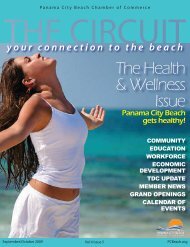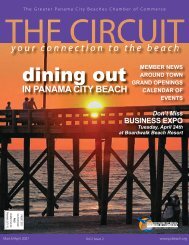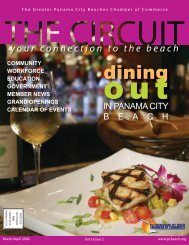View This Issue - Panama City Beach Chamber of Commerce
View This Issue - Panama City Beach Chamber of Commerce
View This Issue - Panama City Beach Chamber of Commerce
Create successful ePaper yourself
Turn your PDF publications into a flip-book with our unique Google optimized e-Paper software.
It was around that time that Kim discovered<br />
the Job Training Partnership Act<br />
(JTPA) Program, which has since evolved<br />
into the Workforce Investment Act, as it is<br />
known today. “I was interested in becoming<br />
a counselor in the JTPA Program at then<br />
the Gulf Coast Community College,” she<br />
says. The program provided assistance to<br />
disadvantaged populations who needed financial<br />
assistance to obtain training. “You<br />
knew you weren’t just changing a person’s<br />
life; you were changing their whole family’s<br />
life. I felt that I had found my calling.”<br />
She began working at Gulf Coast<br />
State College in 1992 as a case manager,<br />
and loved it. She went back to school and<br />
earned her Master’s Degree in Public<br />
Administration at the University<br />
<strong>of</strong> West Florida while working as<br />
a case manager. Within 15 months<br />
she became director <strong>of</strong> the program,<br />
and was director for three years. In<br />
1995, Governor Chiles redesigned<br />
the state’s workforce system. <strong>This</strong><br />
region originally comprised eight<br />
counties, and with the redesign was<br />
split into two regions. Kim became<br />
the Executive Director for the newly<br />
formed three county region made up<br />
<strong>of</strong> Bay, Gulf and Franklin counties<br />
in 1996, where she built the program<br />
from scratch. “I had a real opportunity,”<br />
she says. “You only get one <strong>of</strong><br />
these job opportunities in a lifetime.<br />
I was really blessed. What I love is<br />
to hear someone speak about getting<br />
training…’You guys helped me get training<br />
and now I’m a nurse and my whole family<br />
is doing better.’”<br />
Currently, the Workforce Board has a budget<br />
<strong>of</strong> $6.3 million and 39 funding streams.<br />
“I’ve put everything we do at the Workforce<br />
Board into three buckets,” Kim explains.<br />
“One <strong>of</strong> those is about education and<br />
training. People are laid <strong>of</strong>f, unemployed,<br />
financially or economically disadvantaged,<br />
and our youth programs are also in this<br />
bucket. Everything in this bucket is about<br />
training people for jobs, whether they’re<br />
nine years old or 70 years old. We prepare<br />
them for the workforce, primarily in the traditional<br />
sense through classroom training.<br />
In Gulf County, we have a partnership with<br />
the Jessie Ball duPont Port St. Joe Capacity<br />
Building Fund which allows us to work<br />
with more than 100 kids full time in the<br />
summer months. We help them with reading,<br />
math, sports, teamwork skills and job<br />
readiness. Some people don’t understand<br />
this as workforce readiness, but our youth<br />
are the workforce <strong>of</strong> tomorrow, so we feel<br />
like we are making a good investment with<br />
these kinds <strong>of</strong> programs.”<br />
Kim explains that the second bucket is what<br />
the Workforce Center does through its operations.<br />
“We enjoy a strong relationship<br />
with Gulf Coast State College who operates<br />
the Workforce Center,” she explains.<br />
“Employer services, job-seeker services.<br />
From someone being laid <strong>of</strong>f and filing unemployment<br />
to resume assistance to computer<br />
skills training such as Word and Excel<br />
training.” Last year the center hosted over<br />
200 job fairs, and it additionally provides labor<br />
exchange services. “When a company<br />
downsizes or closes, we want to connect<br />
with the talent that has lost their job and try<br />
to quickly get them plugged back into the<br />
workforce,” she says. “We went to Sally<br />
Mae to meet with employees and help them<br />
with their next step. We also meet with<br />
employers on training issues, training computer<br />
programs, etc.”<br />
The third bucket is all about economic and<br />
community development. The Workforce<br />
Board works closely with the two chambers<br />
<strong>of</strong> commerce and Bay Economic Development<br />
Alliance. “We can provide complete<br />
recruitment, have all applicants come to<br />
their website or ours, screen applications<br />
and pre-screen interviews, pull labor market<br />
data for businesses, unemployment rate,<br />
etc.” she says. “We know that job creation<br />
is key to our community’s economic prosperity.”<br />
Kim believes that our children are our future,<br />
and shaping our children is the most<br />
important thing we will ever do. “In my<br />
work and in life, I think that our children<br />
need us more than ever,” she says. “It is<br />
our job to shape them and have a positive<br />
impact on them. Kids are so smart now,<br />
but I really worry because they are so much<br />
more comfortable interfacing electronically<br />
than in person. We work with a large number<br />
<strong>of</strong> youth in all three counties and <strong>of</strong>ten<br />
I see children, especially teenagers, raising<br />
themselves. No role model in the home,<br />
and single parent families really<br />
struggling to hold it all together. We<br />
see youth aging out <strong>of</strong> foster care,<br />
and those who realistically need to<br />
be in foster care. I know from our<br />
work with state partners that there<br />
is a dire shortage for foster parents.<br />
It breaks my heart.” She also has<br />
concerns about the changes in legislation<br />
including the large amount<br />
<strong>of</strong> testing and “gate keeping” tests.<br />
“Our culture is different from India<br />
and China,” she says. “Our country<br />
tends to preserve and protect childhood,<br />
perhaps at times to a fault. We<br />
want our kids to have a good childhood<br />
experience unmarred by many<br />
<strong>of</strong> the responsibilities that other cultures<br />
consider routine. Looking at<br />
the new standards for high school<br />
graduation makes me concerned for the<br />
kids who aren’t college bound. We may be<br />
so focused on raising the standards for education<br />
that we alienate many students who<br />
might be good workers but will just give up<br />
on the high school diploma.”<br />
Kim lives with her husband Bob and her<br />
two sons, Ryan, 17, and Noah, 14. Bob<br />
was the Workforce Board director in Tallahassee,<br />
and is now retired. “He sometimes<br />
gives me Workforce coaching,” she says.<br />
Kim’s job and interests are very related.<br />
“It’s probably in my DNA to help other<br />
people,” she says. “I am very optimistic,<br />
and feel I was put on this Earth to help<br />
people in whatever way I can. There’s always<br />
someone – from church, a neighbor,<br />
through my job – who needs help. That’s<br />
the person I’m going to be drawn to.”<br />
v v v<br />
THE CIRCUIT September/October 2012 37
















